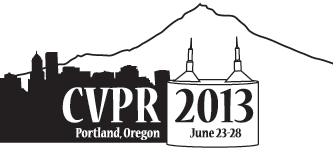-
Grassmannian Sparse Representations and Motion Depth Surfaces for 3D Action Recognition
AbstractManifold learning has been effectively used in computer vision applications for dimensionality reduction that improves classification performance and reduces computational load. Grassmann manifolds are well suited for computer vision problems because they promote smooth surfaces where points are represented as subspaces. In this paper we propose Grassmannian Sparse Representations (GSR), a novel subspace learning algorithm that combines the benefits of Grassmann manifolds with sparse representations using least squares loss L1-norm minimization for optimal classification. We further introduce a new descriptor that we term Motion Depth Surface (MDS) and compare its classification performance against the traditional Motion History Image (MHI) descriptor. We demonstrate the effectiveness of GSR on computationally intensive 3D action sequences from the Microsoft Research 3D-Action and 3D-Gesture datasets.
Related Material
[pdf][bibtex]@InProceedings{Azary_2013_CVPR_Workshops,
author = {Azary, Sherif and Savakis, Andreas},
title = {Grassmannian Sparse Representations and Motion Depth Surfaces for 3D Action Recognition},
booktitle = {Proceedings of the IEEE Conference on Computer Vision and Pattern Recognition (CVPR) Workshops},
month = {June},
year = {2013}
}
These CVPR 2013 workshop papers are the Open Access versions, provided by the Computer Vision Foundation.
Except for the watermark, they are identical to the accepted versions; the final published version of the proceedings is available on IEEE Xplore.
Except for the watermark, they are identical to the accepted versions; the final published version of the proceedings is available on IEEE Xplore.
This material is presented to ensure timely dissemination of scholarly and technical work.
Copyright and all rights therein are retained by authors or by other copyright holders.
All persons copying this information are expected to adhere to the terms and constraints invoked by each author's copyright.

